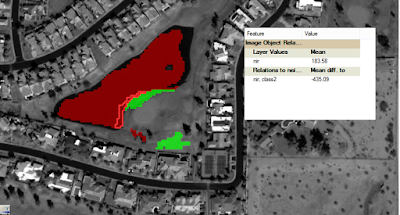I have segmented data, classified into two classes: 1, 2. I would like
to find segments into the 1 class which are adjacent to the 2 class and have
lower mean value. The one condition should be: Existence of 2 > 0, but how
to combine it with information about lower mean value of segment?
This is a problem posted in the eCognition community by one of the user. One of the core strength of OBIA is to incorporate contextual information and class related information in the process which is difficult with pixel-based approaches. Here the class of interest has to satisfy two contextual class related information:
1)
It
must be bordering the class 2
2)
It
must be class 1 and must have lower mean value
 |
| The Problem |
For this problem,
we have to make a class related feature ( Class-Related features > Relation to neigbor objects > Mean diff.
to ) that is based on a layer of interest
and class. For demonstration purpose I will be using NIR layer. So the feature
that is created is “Mean diff to nir, class 2”. In the following figure, we can
see the feature “Mean diff to nir, class 2” on the right side. In the figure,
objects that are not bordering the class 2 have undefined value (red), the
objects that are bordering the class 2 and have lower “Mean diff to nir, class
2”, have smaller value (darker) and the
objects that are bordering the class 2 and have higher “Mean diff to nir, class
2”, have higher value (brighter).
 |
| The custom feature |
For better illustration
I have attached some figures that also show values for “Mean diff to nir, class
2” feature.
 |
| Class 2 object |
 |
| Class 1 object not bordering class 2 |
 |
| Class 2 objects bordering Class 1 |
 |
| Unclassified object bordering Class 1 |
Afterwards, the
extraction of objects of interest is straight forward. We use assign class
algorithm for that purpose.
 |
| Assign class |
 |
| The solution. Pink color represent objects we are attempting to extract. |
No comments:
Post a Comment